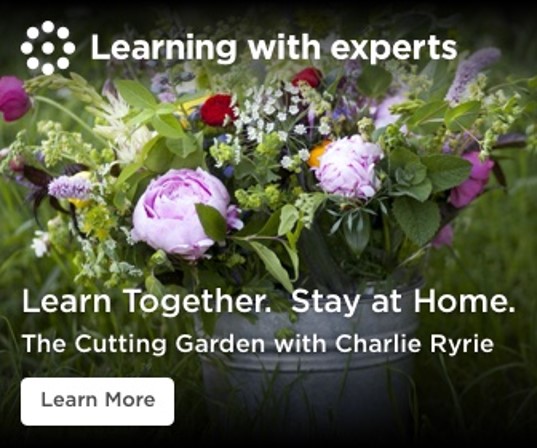How Growing Cut Flowers On A Small Scale Is Helpful For Bees And Wildlife - Lessons For Growers Everywhere
Updated: 25th February 2021
Is it time to support locally grown, small scale cut flower growers? The cut flower industry is huge, and with few exceptions, uses a lot of chemicals. In an interview with Sandra Bright, we discuss with this British grower how growing gorgeous flowers for cutting and selling locally, is helpful for bees, pollinators and other wildlife.
If more people in the UK and other countries start to supply flowers on a small scale, then more pollinator habitats will be created by default! What we don’t want to see, however, is a replication of intensive, high chemical methods dominating the Dutch growing industry.
Growing Bee-Friendly Flowers For Cutting
As a side note:
If this article inspires you, perhaps you'd like to learn how to create a cutting garden on your own land, or know a person who would love a gift voucher for this type of activity instead?
Below is an online course which will teach you not only how to establish and grow a cutting garden, but also how to cut and store the flowers for maximum shelf-life (called 'conditioning'). This latter process is vitally important for anyone wishing to sell their flowers, or arrange them at home.
About Sandra - Cut Flower Grower
Sandra supplies weddings, bouquets, and funerals. She also sells dried flowers. Sandra is a keen gardener, and appeared in the BBC’s Allotment Challenge in 2015.
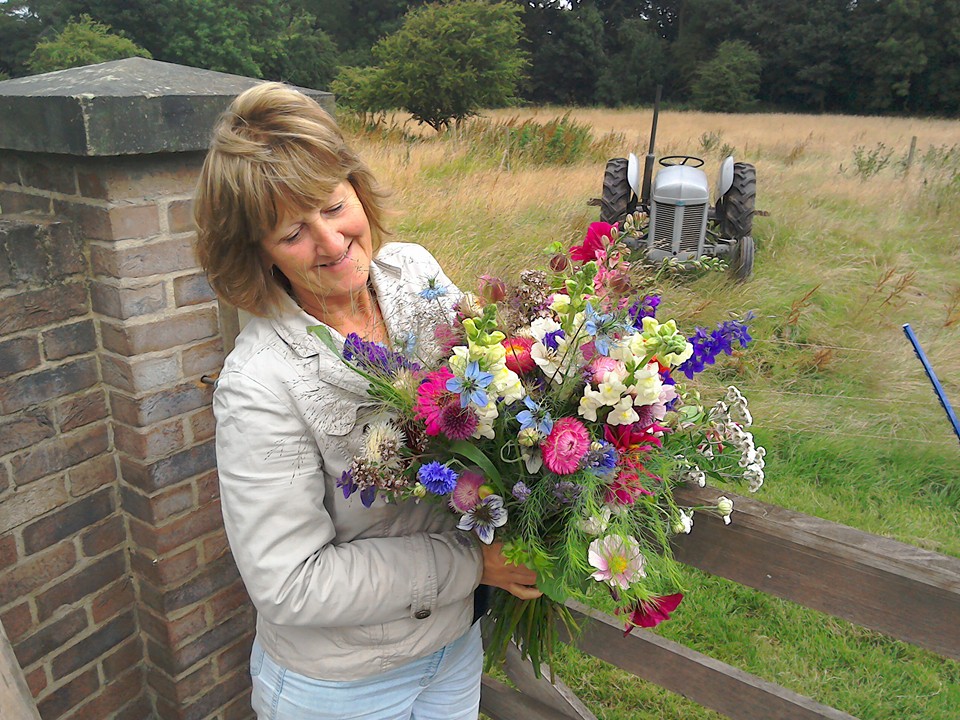 Sandra Bright with one of her creations: a lovely bouquet of English cottage garden flowers all grown from her own plot.
Sandra Bright with one of her creations: a lovely bouquet of English cottage garden flowers all grown from her own plot.
Q. Firstly, please tell us about your plot of land. What is it like,
how much of it is reserved for growing flowers for cutting?
Sandra:
We have about four acres of land where I would say three of it are left
as meadow grass much of the year, where many small mammals live including
moles, mice, field mice, hedgehogs etc and pheasants breed.
In addition, we have five other main areas. One is the front lawn with deciduous trees and evergreens where lots of birds nest. The area is untouched from one year to another, apart from cutting the grass and me collecting materials to make Christmas wreaths.
There is another area where we have a wildlife pond and trees growing, Euphorbia, Aquilegia, shrubs, bulbs etc in an informal way. Next to that area I have my original cutting garden which has beds specifically for growing flowers for cutting. This area is now mainly reserved for perennial flowers for cutting purposes.
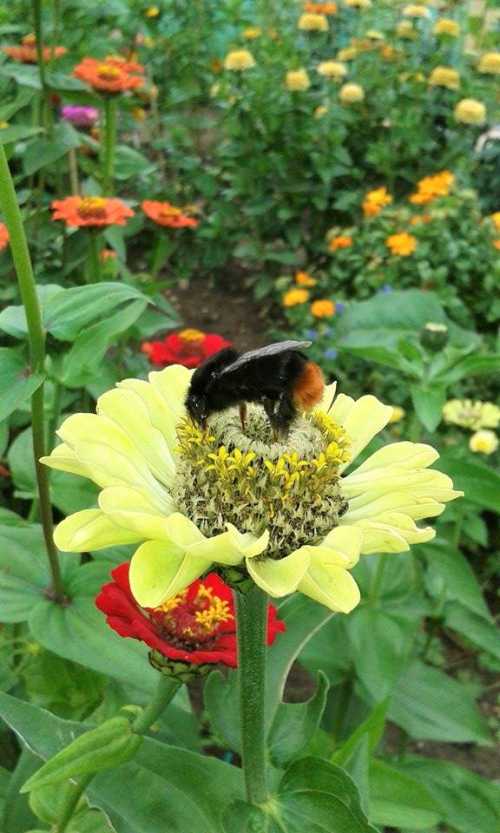 Red-shanked carder bee on a zinnia flower growing in Sandra's plot
Red-shanked carder bee on a zinnia flower growing in Sandra's plotWe have the formal area around the house with hedges, flower borders and patios.
Then we have the vegetable borders which also accommodate two greenhouses.
I grow Perpetual Carnations in one of them. I also grow tomatoes, cucumbers, peppers, and some
cut flowers in one greenhouse and early bulbs in the other, though we do have a third greenhouse waiting to be put up in a field area which is the cutting
paddock. This area is about 70 x 60 feet
I think, and was established this year after the last of our goats passed away
and we decided to use the area to grow flowers for cutting.
I also have flowers in vegetable plots, and mixed in with vegetables. This helps to attract beneficial insects. It was my dream to see swathes of flowers when I looked across from the house.
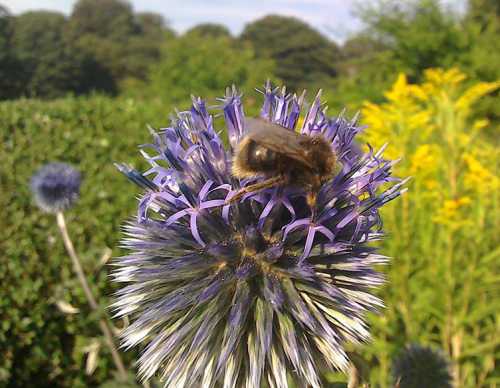
Q. What kinds of flowers do you grow?
Sandra:
We grow mostly English cottage garden favourites that a lot of people
know, but also many flowers that are less well known.
Sadly since the seventies when imported flowers came to this country many British flower growers couldn't compete and folded, and so the abundance of varieties were no longer grown, which meant choice became limited.
I think it’s important, if you are going to sell your flowers, to grow the things people can’t get elsewhere.
I grow lots of bulbs in early spring,
Hellibores, Hyacinths, shrubs, daffs. I have Anemones flowering all through the year, Chrysanthemums in October and November. I now dry flowers, much like the Victorians did, so customers can still have flowers in winter.
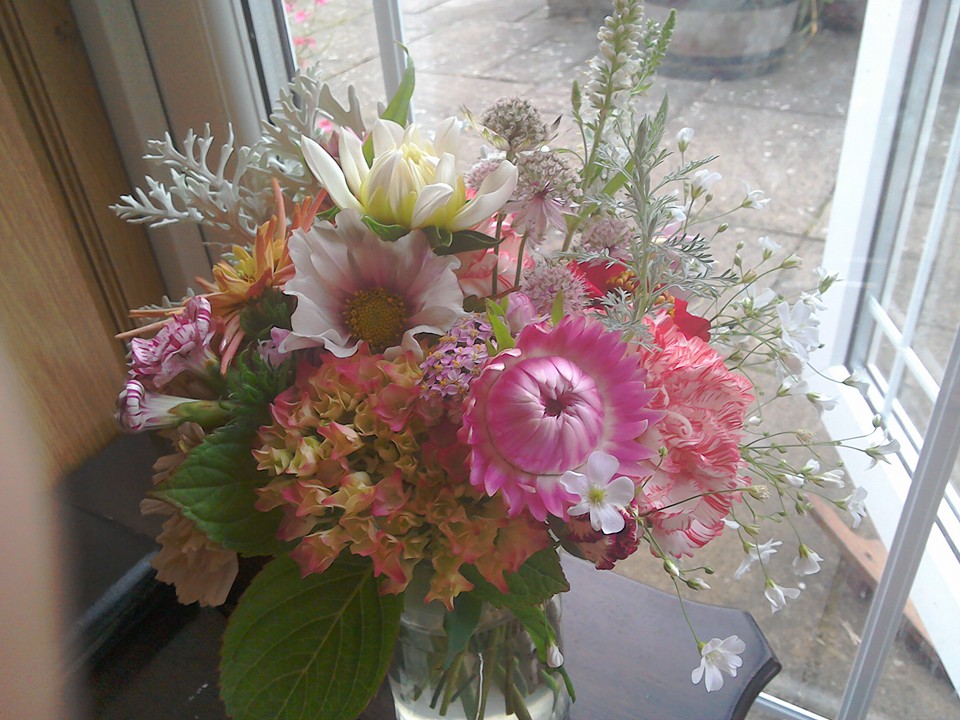 Above: An absolutely stunning vase of flowers all grown on Sandra's plot. Who would have thought we could get such a gorgeous display of this quality from British grown flowers?
Above: An absolutely stunning vase of flowers all grown on Sandra's plot. Who would have thought we could get such a gorgeous display of this quality from British grown flowers?
Q: Who are your main customers, and how do you promote to them? How do they get in touch with you?
Sandra:
Local people are my main customers.
I have a sign outside the house at the bottom of the drive. I find I may sell a bunch for £5, and then
later, the customer may come back to me with an order for £15 or £20.
I use Facebook to promote my bunches of flowers to local groups over the internet –
such as wedding groups, but I don’t trade on-line. I
create wedding flowers myself, but if a wedding seems too big or complicated
for me to handle, I have a contact to whom I can refer the bride. She’ll handle the wedding, and she’ll use my
flowers.
I also sell ‘do it yourself’ buckets of flowers, so brides can buy the flowers and have a relative or friend arrange them. Then again, I post pictures of my wedding designs to inspire people. They feature many pretty country varieties not seen in the shops.
Florists are starting to find us too.
Q: Many people will think it’s not possible to grow beautiful flowers in a climate like that of Britain but that’s not
true is it? Are you growing them from seed/bulb, or are you buying in
plants?
Sandra:
No, it’s not true. You just have
to accept the natural seasons of flowers, but there is always something in
season, for example, aconite and snowdrops in winter. I have made simple bunches
of flowers with snowdrops and evergreen foliage, and people love them.
Plus I find people are getting used to the idea of buying bunches of flowers that are seasonal, and they enjoy it – these flowers welcome in the season, after all.
They all have different scents too. Home grown flowers like this are far more scented than heavily cultivated flowers you buy from supermarkets. I grow flowers with unusual scents as well.
Some of the varieties of Marigold I grow have a very beautiful and distinctive fragrance, quite different from what people are used to.
I do not buy plugs or ready grown plants, I grow everything from seed and I even save seeds from plants. Quite a few of us do this in the small-scale, flower-growing business. For example, I save seeds from Sweet Sultans, Nigella, Cornflower, and Larkspurs.
Q: There seems to be a trend in the public wanting to buy home grown flowers, why do you think this is the case?
Sandra:
Several reasons. Brides are increasingly wanting the natural look and awareness
is growing that buying British flowers offers more variety, scent and even brings
more personality to a bouquet.
Also, at the Royal Wedding, Kate Middleton went for all British flowers in her bouquet and in the church, and people saw what was possible from British growers.
Then there are the older people, who remember the thriving British flower industry in the 1970s, and the amazing variety, before the industry all but disappeared.
On top of this, people are learning more about the flower industry, and they are becoming more and more concerned about the environment, air miles, conditions of work, and chemicals use.
All these developments have been coming together at the same time. We still don’t have enough growers though. There are not enough people out there doing it, and British growers only supply about 5-10% of the market.
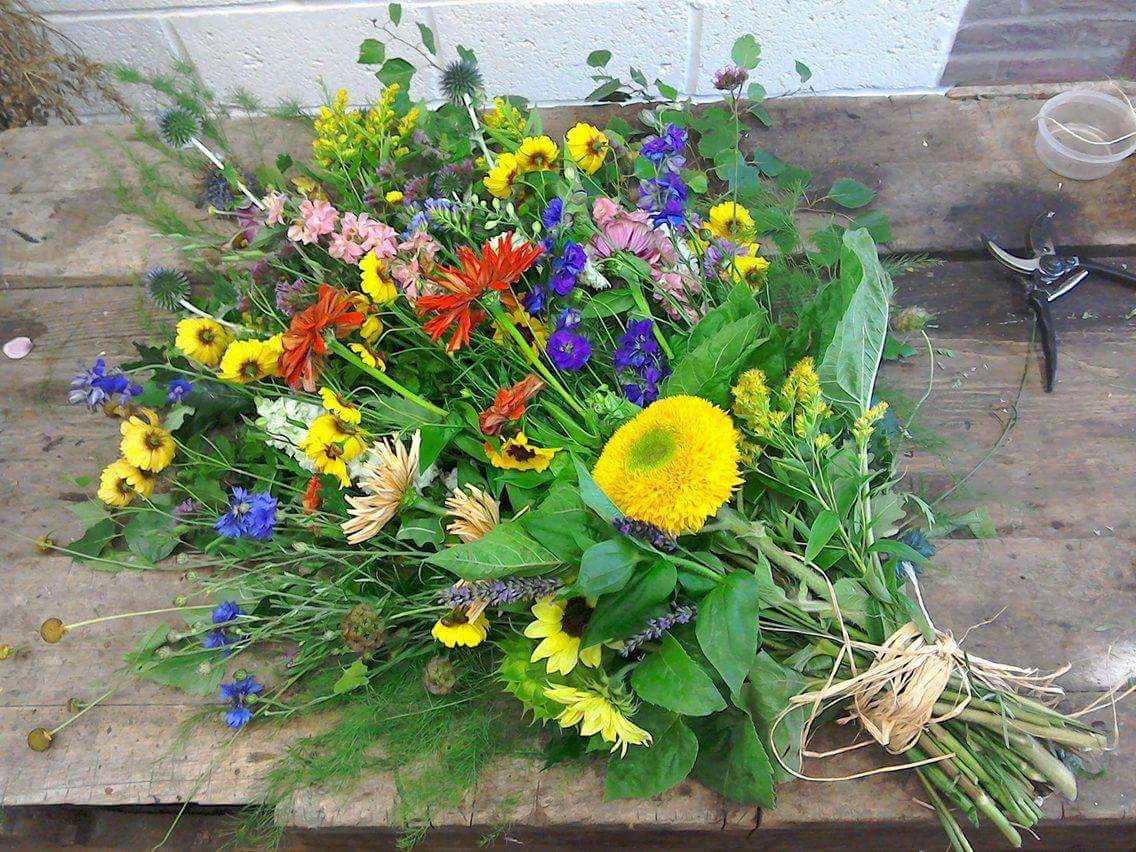
Q: How can people locate growers like you? What if florists want to buy British flowers from a sustainable grower? What can they do?
Sandra:
Google, British Flower Growers to find a local suppler. Check the Flowers From The Farm network, and
British artisan flower growers.
Q: The Dutch have a similar climate to the UK, and their flowers are not all grown in greenhouses. There is a lot of mono-cropping, and agro-chemical use. Your cut
flower beds are abundant with variety, and the
quality is stunning. Do you need lots of chemicals to achieve
this?
Sandra:
The Dutch use systems such as artificial light and chemicals, which
creates an artificial growing atmosphere to provide year round flowers. Growing things in a sustainable, wildlife and environmentally-friendly fashion is more labour intensive.
For example, I grow 100 lilies, and to look after them is very labour intensive, because I have to remove lily beetles by hand.
They weren’t indigenous to this country, but they have spread rapidly since the 1980s. I have had to learn all about the life cycle of the lily beetle so that I can control the populations without spraying the plants.
Q: What practical tips would you have for anyone considering growing a few flowers to sell?
Sandra:
- Grow flowers not commonly seen in supermarkets for example, Phacelia, Sweet Sultan, Nigella, Scabious, Zinnia as well as unusual varieties of flowers. Other than that, also try to grow for scent, because it's important.
- Buy a few cheap annual seeds first, such as Cosmos. They are great for cutting and you can collect the seeds for the following year. Look for the ‘Ideal for cutting’ scissor logo on seed packets.
- Do not cram flowers into your flower bed, space them out properly. It’s better to grow a few plants in a small space, as the yield and quality will be better and you’ll have lots of flowers if you dead head them.
- Go with the flow of the seasons, but remember you can do a certain amount of successional sowing.
- Check the heights on the packets, and plan your beds accordingly. Follow the growing instructions.
- Remember you can grow some flowers for cutting in pots, and also within vegetables and fruit. This will bring beneficial insects to your food crops as well.
- Protect your skin. If a plant has a hairy stem, use gloves to handle them as too much handling can cause skin irritations. The same goes with some sappy stems, such as Euphorbia.
- Whilst growing, water properly, and give them protection from wind if necessary.
- Get to know local florists, and find a florist who will work with your flowers.
- Learn how to condition your flowers. This is very, very important as it makes all the difference in how long the flower lasts. It’s not always a case of simply cutting a stem and popping it into cold water, and it’s handy to know how to revive flowers if they wilt.
Highly recommended is this book The Flower Farmer's Year: How to Grow Cut Flowers for Pleasure and Profit which teaches you how to grow and condition flowers for cutting. The book is written by a flower farmer and florist.
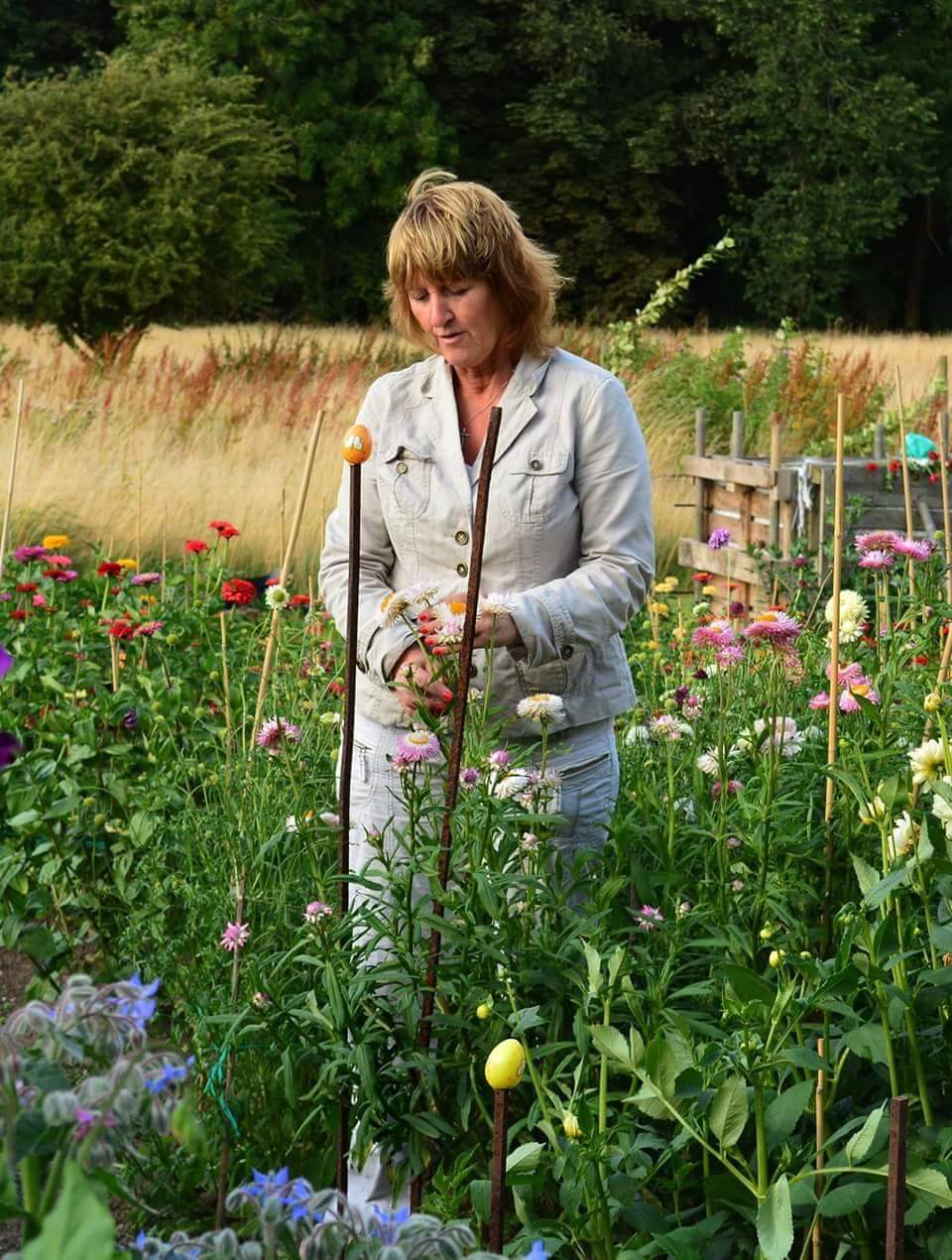 Above: Sandra tending her cutting garden
Above: Sandra tending her cutting garden
Q: What kinds of
arrangements can you make for brides, or are the types of arrangements limited? Do the flowers last, or are
they going to wilt within an hour? Brides need flowers to last a few
hours, after all.
Sandra:
Florists can get far more diversity using British flowers, and
this enables florists to be more creative, and everything can be made, from the bridal bouquet and button holes to table decorations.
If British flowers are
conditioned properly they can last longer than shop bought flowers, because
they have not spent days travelling. In theory they can be seen by the bride a couple of days before the wedding, and picked the day before for conditioning. My peony double flowering tulips last 10 days.
Q: Some people may think the flowers are cut before
the bees have a chance, but that’s not true is it? You seem to have bees
all over the place. What sort of wildlife
visitors are you getting?
Sandra:
My plot is abundant with hummingbird hawk-moths, hoverflies, butterflies, bees, hedgehogs, birds,
deer, rabbits. Lots of wildlife!
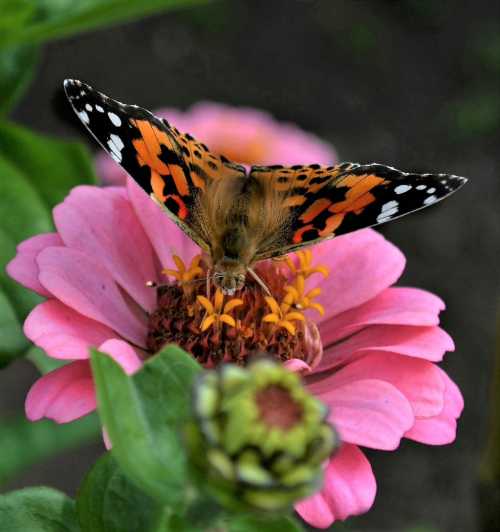 Painted Lady butterfly (female) on Zinnia
Painted Lady butterfly (female) on Zinnia
Q: So what about autumn and winter, is it all over with the flowers?
What do you do then?
Sandra:
I offer dried flowers, Christmas wreaths and arrangements.
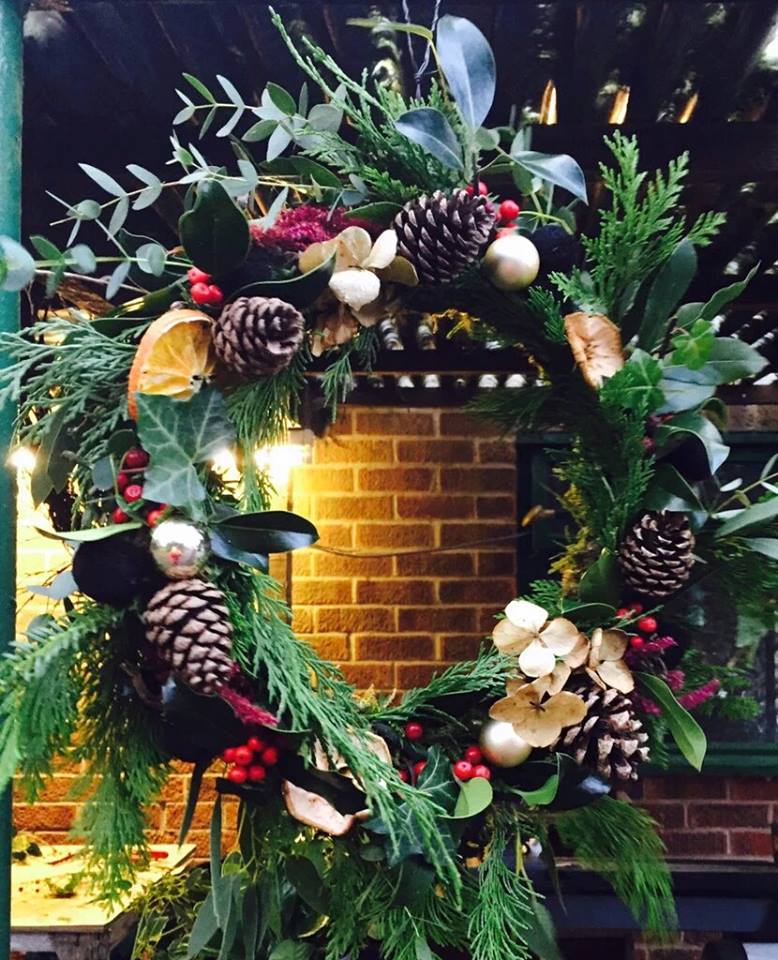 A Christmas wreath made by Sandra
A Christmas wreath made by SandraQ: How can customers contact you?
Sandra:
Contact me via Flowers From The Farm or contact me on Facebook.
The Best Flowers To Grow For Cutting (and for pollinators!)
This selection is based on value to pollinators (especially bees), and covers country garden style flowers and herbs for growing outdoors only, rather than exotic blooms for the greenhouse.
This list does not include shrubs, trees or foliage.
|
Dahlia |
Eryngium |
Starting A Cut Flower A Business
Here are a few tips and ideas. I have not covered off insurances, health and safety, local regulations etc.
Tips for selling cut flowers at a farmers' market
- Visit the market first. Is there scope for a cut flower stall? What is the foot-flow like, will it be worth your effort?
- Contact the organisers, check requirements and cost for a stall: Are there regulations or a protocol? Is a stand provided? Is there access to water? How will you take payments? What time do you need to set up and dismantle your stand?
- Is there scope for sharing a stand at first to test reaction?
- Remember you will need equipment: water buckets, tie string, scissors, wrapping, secateurs, sellotape.
- Remember, your flowers need to be cut and conditioned properly, ideally the night before to give them a good drink.
- Make a number of flower bunches in advance, at different price points.
- Keep wrapping simple and "country" in style, try to add a personal touch.
- Link into the farmers' market and local social media groups, take some pictures of your bunches, and post them there, letting everyone know you'll be at the farmers' market.
Tips for selling your cut flowers on-line
An advantage here is that you can cut the flowers only when the order comes in, and potentially send them all over the country.
- Factor in the cost of postage and packaging.
- Some flowers may not travel so well as others.
- Provide clear instructions to the customer with regard to re-cutting the stems, and placing in water.
- How will you cope with complaints due to damages, goods going missing, bad reviews etc.
- Factor in the cost of building the website, hosting etc.
Tips for selling your cut flowers to a florist
- Get to know a couple of florists, visit them with a few of your bunches, and let them know what you have to offer, and what is coming up.
- Develop an email list, so that you can inform them about "What's ready now".
- Be ready to tell a florist your prices (e.g. 10 stems of Larkspur for X price; 20 stems of Cosmos for Y price).
- Florists may wish to buy foliage as well, if you have it.
- Pick and condition the flowers, and inform the florist about how the flowers will be delivered to them.
- Be clear about credit. A florist may not pay you up front, but may be prepared to pay you in a week or two. You need to decide on your credit terms and be clear from the start. If offering credit, keep your paperwork up to date and keep appropriate records.
Tips: Buying British Grown Cut Flowers
- Check local farmers' market; they may also advertise locally, via social media, newspapers.
- If planning a wedding or event, contact the grower in advance to discuss your needs.
- Find out whether the grower is also an arranger, or whether their flowers need to be arranged elsewhere.
- Have in mind a budget, and confirm it. Pay a fair price.
- Be as flexible as possible. If you want a pretty, country cottage garden look, then allow the grower to supply what they can naturally grow. If they are skilled in arranging, allow them free rein as much as possible, because if you like their arrangements generally, you are more likely to be happy with the result.
- If sourcing British flowers via a florist, be sure they understand your interpretation of British grown country flowers, if that is what you are after. You can check this by ordering a hand tie for yourself in advance of booking an event.
If you found this page helpful or interesting, I'd really be grateful if you would share it with others - if not this page, perhaps another, such as Gardening For Bees.
Thank you so much :) .
